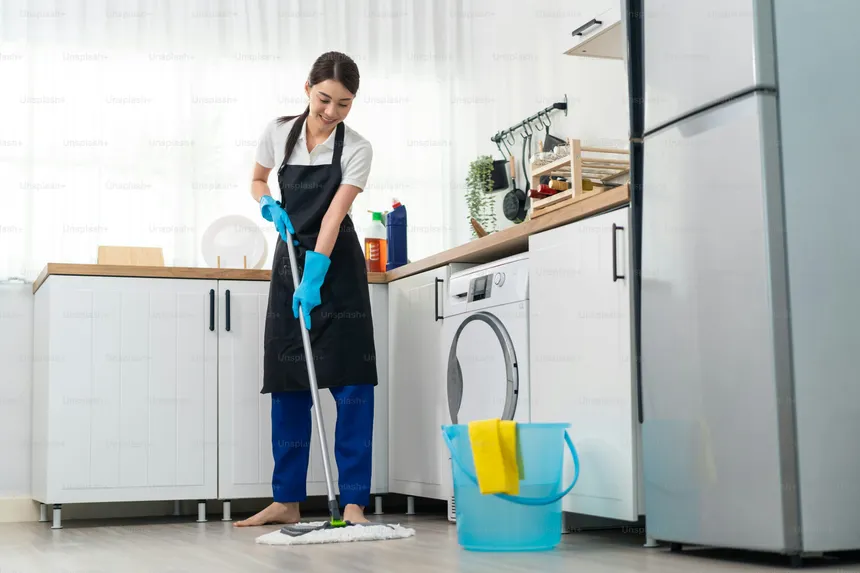A tidy house is not only a matter of looks; it also relates to health, comfort, and mental wellness. But have you ever thought about why some cleaning methods appear to be more effective than others? The key is scientific. Whether it’s the chemistry of cleaning products or the psychology of habits, grasping the reasons behind cleaning can enable you to work more efficiently.
In this article, we will delve into the scientific principles that underlie a successful clean and share practical advice to enhance the efficiency and durability of your cleaning endeavors.
1. The Chemistry of Cleaning
Cleaning is more than just wiping away dirt — it’s about breaking down and removing unwanted substances at a microscopic level. Here’s how it works:
-
Soaps and Detergents: These contain molecules with a “water-loving” (hydrophilic) end and an “oil-loving” (hydrophobic) end. This unique structure lets them grab onto grease and grime while being rinsed away with water.
-
Acidic Cleaners: Ingredients like vinegar or citric acid break down mineral deposits, soap scum, and hard water stains by dissolving alkaline substances.
-
Alkaline Cleaners: Baking soda or ammonia work well on fats and oils because they neutralize acids and emulsify grease.
Why it matters: Picking the appropriate cleaner for the specific type of mess can help you save time and energy. As an illustration, vinegar is excellent for limescale removal but does not effectively tackle heavy grease — this requires a cleaner with an alkaline base.
2. The Role of Time in Cleaning
One of the most overlooked aspects of cleaning is dwell time — the amount of time a cleaner needs to sit on a surface to work effectively.
For example:
-
Disinfectants usually require 5–10 minutes to kill germs completely.
-
Stain removers work better when given time to penetrate the fibers.
-
Degreasers need a short soak to break down stubborn oils.
Pro tip: Spraying and immediately wiping isn’t always the most effective method. Letting the product work before scrubbing can cut your effort in half.
3. Heat Speeds Up the Process
Heat helps cleaning in several ways:
-
It softens grease, making it easier to wipe away.
-
Hot water boosts the effectiveness of detergents by reducing surface tension.
-
Steam can sanitize without chemicals by killing bacteria and loosening dirt.
That’s why dishwashers and steam mops are so effective — they use a combination of heat, moisture, and cleaning agents to get superior results.
4. Microfiber vs. Regular Cloths
Anyone who has made the switch from a regular rag to a microfiber cloth knows it makes a huge difference. The scientific discipline?
Microfiber cloths consist of tiny synthetic fibers that are divided into even smaller strands, resulting in millions of microscopic hooks that lift and capture dirt, dust, and bacteria. Regular cotton fabrics usually displace dirt rather than collect it.
Why it matters: Microfiber can clean surfaces with just water, making it eco-friendly and cost-effective. It’s especially effective for dusting, glass cleaning, and removing allergens.
5. The Order You Clean In Matters
There’s a reason professional cleaners follow a specific sequence:
-
Top to bottom: Start with higher surfaces like shelves and countertops, then work your way down to the floors. This prevents dust and debris from falling onto areas you’ve already cleaned.
-
Clean before disinfecting: Dirt and grime can block disinfectants from working properly. Always remove visible mess first.
Why it works: Following a structured cleaning order ensures you’re not undoing your own work.
6. The Psychology of a Clean Home
Studies indicate that an organized environment can reduce stress and enhance productivity. Clutter overstimulates the brain, complicating concentration.
By breaking cleaning into manageable, consistent tasks—such as nightly sink wipes or short 10-minute decluttering sessions—you can prevent mess accumulation and maintain a fresh home without requiring significant effort.
Tip: Use the “two-minute rule” — if something takes less than two minutes to clean or put away, do it immediately.
7. Why Some People’s Homes Stay Clean Longer
It’s not magic — it’s maintenance. The science here is about prevention:
-
Doormats reduce 85% of dirt tracked inside.
-
Air purifiers reduce dust buildup by trapping airborne particles.
-
Regular decluttering limits the surfaces where dust can settle.
Small preventive steps mean less deep cleaning over time.
Final Thoughts
To achieve a cleaner home, it’s not a matter of putting in more effort — it’s about using one’s efforts more intelligently. By comprehending the scientific principles behind cleaning—ranging from product chemistry to habitual psychology—you can select appropriate tools, apply effective techniques, and achieve superior outcomes with reduced exertion.
The next time you grab that spray bottle or mop, keep in mind that a little science can greatly contribute to a cleaner, healthier, and happier home. You must try Nuroclean Tablets.










Leave a Reply